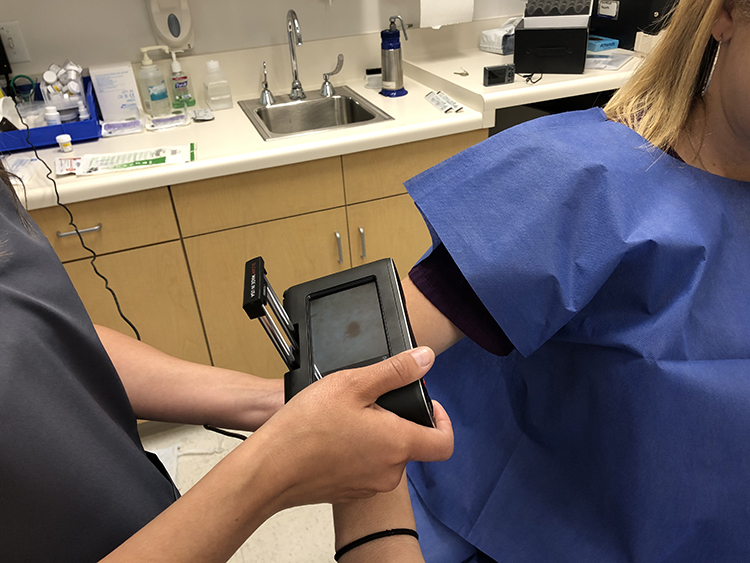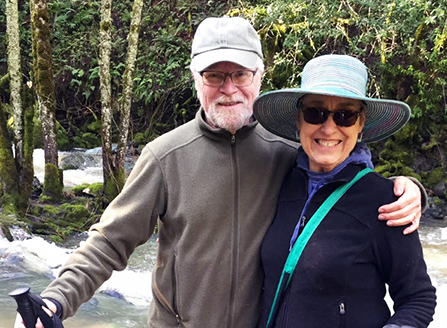Leong Koh, MD, on why a clinician's wellness is inextricably linked to the quality and safety of patient care, and how innovation can help.

Taking a photo of a suspicious mole with a dermatoscope.
Teledermatology: delivering fast, high-quality care to fight skin cancer
Technology and roving dermatologists help primary care physicians examine skin conditions
By Anna Fiddler and Janet Byron
First, David Ebright noticed a suspicious mole on his stomach.
He snapped a picture and sent it to his Permanente physician via kp.org; his doctor told him to come in for a closer look.
“My primary care physician confirmed that, yes, the mole looked suspicious. He took a photo with a special camera and emailed the image to the dermatologist,” said Ebright, who works as a public affairs manager for Kaiser Permanente in Marin and Sonoma.
Ebright’s doctor used a digital camera fitted with a dermatoscope, which is a strong magnifying glass coupled with a bright light that can be optimized to look at the surface of the skin or the layers underneath.
Less than 48 hours later, Ebright got a call from Mark Cheiken, MD, a dermatologist with The Permanente Medical Group.

“He said I needed to come in. I scheduled an appointment and he biopsied it, which confirmed melanoma,” Ebright said. “I went in for outpatient surgery and a surgeon did a further excision of the mole and the margin around it. I got an email a few days later: ‘Good news, no cancer!’”
An innovative program
Kaiser Permanente’s teledermatology program in Northern California has been in place for more than a decade, and it is believed to be one of the largest anywhere, with an estimated 150,000 interactions between physicians and patients in 2018 alone.
In a few of the region’s 21 medical centers, Permanente physicians in primary care can request a “roving” dermatologist visit exam rooms and look at rashes and skin lesions, while at most medical centers physicians can take pictures and transmit them to on-call dermatologists before having patients come in for a visit in the Dermatology Department.
“One in 5 people in this country develops a skin cancer,” said Sangeeta Marwaha, MD, a TPMG dermatologist at the Kaiser Permanente South Sacramento Medical Center and lead author of a Kaiser Permanente teledermatology study. “That’s a large and growing population that needs dermatological care. With teledermatology, we are looking for innovative ways to deliver fast and high-quality care to people who need it.”
More cancers found, fewer referrals
Dr. Marwaha’s study, conducted with Lisa J. Herrinton, PhD, research scientist with the Kaiser Permanente Division of Research, included nearly 60,000 adult Kaiser Permanente members in Northern California who asked their primary care physician to take a look at a worrying skin lesion during the first half of 2017.
When Permanente on-call dermatologists, in partnership with primary care physicians, had the opportunity to look at skin lesions well-photographed with the dermatoscope, they identified 9 percent more cancers with 39 percent fewer referrals to Dermatology Departments.
“Cancerous lesions have certain qualities such as irregular color and shape, bleeding, and textural crustiness that benign lesions don’t have,” Marwaha said. “The workflow using the dermatoscope and a high-resolution camera allowed the ability for us to see some of the lesion’s subtler qualities.”
May is Skin Cancer Awareness Month, and Ebright encourages Kaiser Permanente members to pay attention and act on their instincts when they notice something on their skin that doesn’t seem right.
“This happened on my stomach, on an area that is typically covered. But I just knew I had to go and check it out,” Ebright said.
Anna Fiddler is a staff writer with Kaiser Permanente Northern California Communications and Janet Byron is a senior communications consultant with the Kaiser Permanente Division of Research. This story is reprinted from the InsideKP Northern California site.


